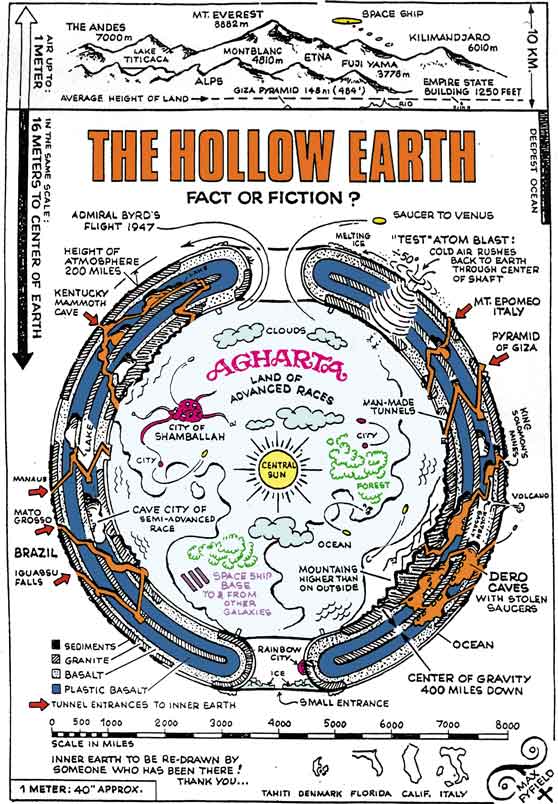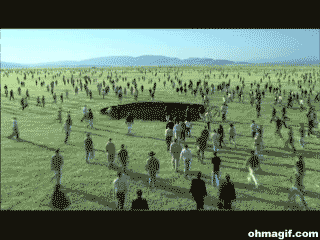All on needs to do is go to the opening at the North Pole and jump in. The biggest danger would come from venturing too close to the central sun.

Posted on 04/19/2014 8:40:10 AM PDT by doug from upland
Q: If you could drill a tunnel through the whole planet and then jumped down this tunnel, how would you fall?
Posted on August 3, 2012 by The Physicist
Physicist: This is a beautiful question, in a small part because it’s an interesting thought experiment with some clever math, but mostly because of all the reasons it couldn’t be done and wouldn’t work. Right off the bat; clearly a hole can’t be drilled through the Earth. By the time you’ve gotten no more than 30 miles down (less than 0.4% of the way through) you’ll find your tunnel filling will magma, which tends to gunk up drill bits (also melt everything).
Jumping into a hole drilled through the Earth. What’s the worst that could happen?
But! Assuming that wasn’t an issue, and you’ve got a tube through the Earth (made of unobtainium or something), you still have to contend with the air in the tube. In addition to air-resistance, which on its own would drag you to a stop near the core, just having air in the tube would be really really fatal. The lower you are, the more air is above you, and the higher the pressure. The highest air pressure we see on the surface of the Earth is a little under 16 psi. But keep in mind that we only have about 100 km of real atmosphere above us, and most of that is pretty thin. If the air in the tube were to increase in pressure and temperature the way the atmosphere does, then you’d only have to drop around 50 km before the pressure in the tube was as high as the bottom of the ocean.
Even worse, a big pile of air (like the atmosphere) is hotter at the bottom than at the top (hence all the snow on top of mountains). Temperature varies by about 10°C per km or 30 °F per mile. So, by the time you’ve fallen about 20 miles you’re really on fire a lot. After a few hundred miles (still a long way from the core) you can expect the air to be a ludicrously hot sorta-gas-sorta-fluid, eventually becoming a solid plug.
But! Assuming that there’s no air in the tube, you’re still in trouble. If the Earth is rotating, then in short order you’d be ground against the walls of the tunnel, and would either be pulverized or would slow down and slide to rest near the center of the Earth. This is an effect of “coriolis forces” which show up whenever you try to describe things moving around on spinning things (like planets). To describe it accurately requires the use of angular momentum, but you can picture it pretty well in terms of “higher things move faster”. Because the Earth is turning, how fast you’re moving is proportional to your altitude. Normally this isn’t noticeable. For example, the top of a ten story building is moving about 0.001 mph faster than the ground (ever notice that?), so an object nudged off of the roof can expect to land about 1 millimeter off-target. But over large changes in altitude (and falling through the Earth counts) the effect is very noticeable: about halfway to the center of the Earth you’ll find that you’re moving sideways about 1,500 mph faster than the walls of your tube, which is unhealthy.
The farther from the center you are, the faster you’re moving.
But! Assuming that you’ve got some kind of a super-tube, that the inside of that tube is a vacuum, and that the Earth isn’t turning (and that there’s nothing else to worry about, like building up static electricity or some other unforeseen problem), then you would be free to fall all the way to the far side of the Earth. Once you got there, you would fall right through the Earth again, oscillating back and forth sinusoidally exactly like a bouncing spring or a clock pendulum. It would take you about 42 minutes to make the trip from one side of the Earth to the other.
The clever math behind calculating how an object would fall through the Earth: As you fall all of the layers farther from the center than you cancel out, so you always seem to be falling as though you were on the the surface of a shrinking planet.
What follows is interesting mostly to physics/engineering majors and to almost no one else.
It turns out that spherically symmetric things, which includes things like the Earth, have a cute property: the gravity at any point only depends on the amount of matter below you, and not at all on the amount of matter above you. There are a couple of ways to show this, but since it was done before (with pictures!), take it as read. So, as you fall in all of the layers above you can be ignored (as far as gravity is concerned), and it “feels” as though you’re always falling right next to the surface of a progressively smaller and smaller planet. This, by the way, is just another reason why the exact center of the Earth is in free-fall.
The force of gravity is F = -\frac{GMm}{r^2}, where M is the big mass, and m is the smaller, falling mass. But, since you only have to consider the mass below you, then if the Earth has a fixed density (it doesn’t, but if it did) then you could say M = \rho \frac{4}{3}\pi r^3, where ρ is the density. So, as you’re falling F = -\left(\frac{Gm}{r^2}\right)\left(\rho \frac{4}{3}\pi r^3\right) = -\left(\frac{4}{3}G\rho \pi\right) mr.
Holy crap! This is the (in)famous spring equation, F = – kx! Physicists get very excited when they see this because it’s one of, like, 3 questions that can be exactly answered (seriously). In this case that answer is r(t) = R\cos{\left(t\sqrt{\frac{4}{3}G\rho \pi} \right)}, where R is the radius of the Earth, and t is how long you’ve been falling. Cosine, it’s worth pointing out, is sinusoidal.
Interesting fun-fact: the time it takes to oscillate back-and-forth through a planet is dependent only on the density of that planet and not on the size!
the ability to stop the Earth from rotating for only 42 minutes. The rest (as an infuriating old math professor of mine used to say) is merely engineering.
+++++++++++++++++++++++++++++++++++++++++++++++++++++++++++++++++++++++++++++++++++++++++++++++++++++++++++++++++++++++++++++++++++
You don’t need to stop the earth from rotating if you drill along the axis of rotation. That IS engineering.
It would certainly open up my sinuses.
All on needs to do is go to the opening at the North Pole and jump in. The biggest danger would come from venturing too close to the central sun.

Well, you'd also have to hold your breath for 42 minutes, I suppose. Or jump with a scuba tank rated to 100 zillion atmospheres. Details.
Not unless you can jump at about 128 miles an hour straight upward.
By jumping, you're reducing your velocity relative to the elevator, but relative to the shaft (and the floor you're falling toward) only minimally.
Which of course begs the question - "Would Laz hit it?"
You mean like this?
Sounds like I have some work to do. Time to hit the jump rope. Just in case.
I was waiting for that. Can we strap a video camera onto one of those folks?
What I keep all my bitcoin in. (Mum's the word.)
Sounds like sound science to me, observable, reportable, but it is missing one ingredient.. oh ya, repeatable. It needs to be repeatable to be science, can you revise your theory a bit?
Perhaps be more inclusive of other fine individuals?
Of course it would, what are you... simple? /s
That poses another interesting question.
When you finally came to a stop at the center of the Earth pendulumically, (or artificially somehow, if you have somewhere to be that night), what would it feel like?
Would you simply be weightless?

“Cosines include an angle that’s a-cutie.”
Instead of going off on a Tangent, perhaps you could stay focused.
A and B might be able to imagine such a thing, but C can’t.
I would have gone with an otolaryngologist first.
Just make sure any prescription is "Sined, Seeled, Delivered".
You’d never survive!! The center of the earth is over a million degrees F. < /algore>
I was surprised it had not yet been posted! Since politicians crave the media spotlight and are rarely elected for their intelligence, perhaps a pol might be convinve to wear a camera while jumping in.
Disclaimer: Opinions posted on Free Republic are those of the individual posters and do not necessarily represent the opinion of Free Republic or its management. All materials posted herein are protected by copyright law and the exemption for fair use of copyrighted works.